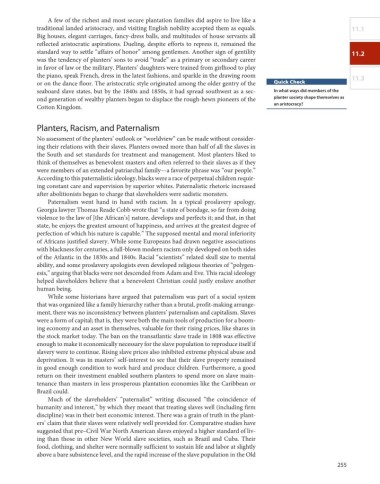Page 288 - American Stories, A History of the United States
P. 288
A few of the richest and most secure plantation families did aspire to live like a
traditional landed aristocracy, and visiting English nobility accepted them as equals. 11.1
Big houses, elegant carriages, fancy-dress balls, and multitudes of house servants all
reflected aristocratic aspirations. Dueling, despite efforts to repress it, remained the
standard way to settle “affairs of honor” among gentlemen. Another sign of gentility 11.2
was the tendency of planters’ sons to avoid “trade” as a primary or secondary career
in favor of law or the military. Planters’ daughters were trained from girlhood to play
the piano, speak French, dress in the latest fashions, and sparkle in the drawing room 11.3
or on the dance floor. The aristocratic style originated among the older gentry of the Quick Check
seaboard slave states, but by the 1840s and 1850s, it had spread southwest as a sec- In what ways did members of the
ond generation of wealthy planters began to displace the rough-hewn pioneers of the planter society shape themselves as
Cotton Kingdom. an aristocracy?
Planters, Racism, and Paternalism
No assessment of the planters’ outlook or “worldview” can be made without consider-
ing their relations with their slaves. Planters owned more than half of all the slaves in
the South and set standards for treatment and management. Most planters liked to
think of themselves as benevolent masters and often referred to their slaves as if they
were members of an extended patriarchal family—a favorite phrase was “our people.”
According to this paternalistic ideology, blacks were a race of perpetual children requir-
ing constant care and supervision by superior whites. Paternalistic rhetoric increased
after abolitionists began to charge that slaveholders were sadistic monsters.
Paternalism went hand in hand with racism. In a typical proslavery apology,
Georgia lawyer Thomas Reade Cobb wrote that “a state of bondage, so far from doing
violence to the law of [the African’s] nature, develops and perfects it; and that, in that
state, he enjoys the greatest amount of happiness, and arrives at the greatest degree of
perfection of which his nature is capable.” The supposed mental and moral inferiority
of Africans justified slavery. While some Europeans had drawn negative associations
with blackness for centuries, a full-blown modern racism only developed on both sides
of the Atlantic in the 1830s and 1840s. Racial “scientists” related skull size to mental
ability, and some proslavery apologists even developed religious theories of “polygen-
esis,” arguing that blacks were not descended from Adam and Eve. This racial ideology
helped slaveholders believe that a benevolent Christian could justly enslave another
human being.
While some historians have argued that paternalism was part of a social system
that was organized like a family hierarchy rather than a brutal, profit-making arrange-
ment, there was no inconsistency between planters’ paternalism and capitalism. Slaves
were a form of capital; that is, they were both the main tools of production for a boom-
ing economy and an asset in themselves, valuable for their rising prices, like shares in
the stock market today. The ban on the transatlantic slave trade in 1808 was effective
enough to make it economically necessary for the slave population to reproduce itself if
slavery were to continue. Rising slave prices also inhibited extreme physical abuse and
deprivation. It was in masters’ self-interest to see that their slave property remained
in good enough condition to work hard and produce children. Furthermore, a good
return on their investment enabled southern planters to spend more on slave main-
tenance than masters in less prosperous plantation economies like the Caribbean or
Brazil could.
Much of the slaveholders’ “paternalist” writing discussed “the coincidence of
humanity and interest,” by which they meant that treating slaves well (including firm
discipline) was in their best economic interest. There was a grain of truth in the plant-
ers’ claim that their slaves were relatively well provided for. Comparative studies have
suggested that pre–Civil War North American slaves enjoyed a higher standard of liv-
ing than those in other New World slave societies, such as Brazil and Cuba. Their
food, clothing, and shelter were normally sufficient to sustain life and labor at slightly
above a bare subsistence level, and the rapid increase of the slave population in the Old
255

